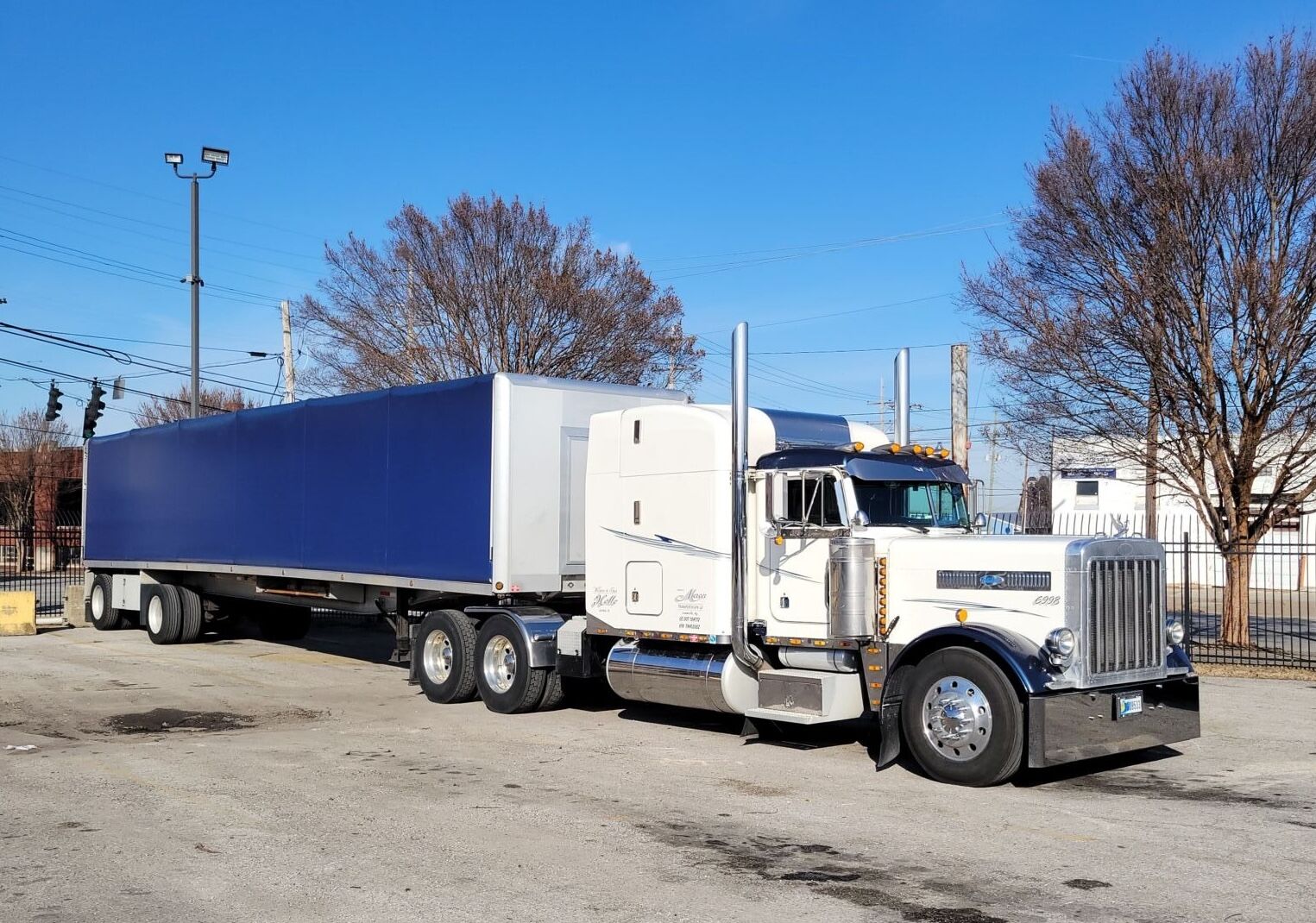Conestoga Trucks and Trailers: Game Changers for Safe Transportation
When it comes to transporting goods across vast distances, few pieces of equipment can compete with the versatility and practicality of Conestoga trailers.
As you search for solutions for shipping your goods, you may come across the term – “Conestoga”. Derived from the Conestoga wagons widely used by pioneers during the 18th and 19th centuries, the Conestoga now represents a powerful tool used by truck drivers in our modern era.

Promising protection from external elements and flexibility in terms of size, Conestoga trailers offer compelling advantages that make them stand out in the trucking industry.
What is a Conestoga Trailer and How Does it Work?
A Conestoga trailer is essentially a flatbed equipped with a flexible, rolling tarp system that covers the cargo, providing a secure and adaptable environment for freight.
The retractable tarp system covers your cargo, simulating the effects of a standard van trailer, while offering the versatility and accessibility of a flatbed trailer. With the help of this system, freight can be quickly and conveniently loaded and unloaded from either side, the back, or over the top of the trailer.
Whereas typical flatbed trailers require manual labor to secure tarps after loading, a Conestoga trailer has a sliding tarp system. This sliding tarp is connected to two parallel rails that extend along the length of the trailer. When sliding these tarps forward or backward, you create a safe lift-free loading environment. Securing the tarp after loading is as simple as drawing it along these rails, covering your load.
This design is beneficial for protecting sensitive loads from weather conditions and road debris and dealing with a variety of freights – from palletized freight, vehicles, and heavy machinery.
Types of Conestoga Trailers
Conestoga trailers vary in design to cater to different transportation needs. The main types include flatbed, step-deck, and double drop trailers, each serving unique purposes in the transportation industry.

Flatbed Conestoga
The Conestoga flatbed trailer is the most common type, generally used to ship open-deck commodities and cargo similar to those transported on traditional open-deck flatbed trailers but require additional protection. It is simply a flatbed trailer fitted with a rolling tarp-on-frame system. This combination is perfect for transporting large or unusually shaped freight, offering the space of a flatbed and the protection of a dry van trailer.
- Length Capabilities: 48 Feet and 53 Feet
- Height: 96 inches
- Weight Capacity: 44,000 pounds
Step-Deck Conestoga
Step-deck Conestoga trailers, also known as drop deck trailers, are designed to transport goods that exceed the height capacity of flatbed Conestoga trailers. They have a lowered deck with a “stepped” design, which provides additional vertical space for taller items, making them suitable for transporting large freight.
- Length Capabilities: 48 Feet and 53 Feet
- Upper Deck Height: 96 inches
- Lower Deck Maximum Height: 110 inches
- Weight Capacity: 41,000 pounds
Double Drop Conestoga
Double-drop Conestoga trailers are the go-to choice for large or heavy loads. They feature a central ‘well’ or ‘drop’ that provides a lower center of gravity and additional clearance for oversized equipment or extremely high loads. The trailer still features the same tarp-on-frame protection offered by all Conestogas.
- Length Capabilities: 48 Feet
- Front Deck Maximum Height: 96 inches
- Lower Deck Maximum Height: 139 inches
- Rear Deck Maximum Height: 114 inches
- Weight Capacity: 35,000 pounds
Understanding these variations can help you determine which best suits your unique shipping requirements.
Advantages of Shipping with Conestoga Trailers
Beyond their distinctive design, Conestoga trailers offer numerous benefits that make them a preferred choice for many industries.
1. Versatility in Cargo Transportation
Conestoga trailers can handle a wide range of cargo types. Whether it’s palletized goods, machinery, or irregularly shaped items, these trucks can accommodate loads of various sizes and shapes. This versatility ensures that different kinds of cargo can be transported without the need for multiple types of vehicles
2. Protection Against Harsh Elements
The retractable tarping system protects from environmental factors such as rain, snow, wind, and sun. This feature is crucial for items that are sensitive to weather conditions, ensuring that goods arrive at their destination in the same condition as they were loaded
3. Ease of Loading and Unloading
Conestoga trailers’ design allows easy access to the cargo area from the sides or top, making the loading and unloading process quicker and less labor-intensive. This is beneficial for cargo that requires handling from multiple angles or is too bulky for traditional loading docks
4. Retractable Tarping System
The rolling tarp system on Conestoga trailers can be easily moved back and forth, providing quick and easy access to the cargo without the need for manual tarping. This system saves time and reduces the physical effort required to secure the cargo, minimizing the risk of damage during the process.
Choosing the Right Trailer for Your Shipment
When it comes to deciding the right trailer for your freight, several factors come into play. Not all goods are the same in terms of their size, weight, and sensitivity to environmental conditions. As a result, it is important to evaluate the different types of trailers and choose the one that best fits the transportation needs of your goods. Here are a few factors to consider:
- Evaluate Equipment Types: Consider the nature of your goods first. If you’re shipping tall items, a double-drop Conestoga might be the best option due to its lower deck height. For most standard goods, a flatbed Conestoga should suffice.
- Tailor Solutions to Fit Your Freight Needs: Be aware of your freight’s specific needs. For instance, if your cargo is sensitive to weather conditions such as rain or extreme heat, a Conestoga trailer would be ideal thanks to the tarping system that protects your goods from such elements. If your cargo requires side-loading or unloading, again, a Conestoga trailer would be an excellent choice due to its versatile loading and unloading capabilities.
- Partner with a Reliable Driver and Team: The integrity of your shipment relies not just on the equipment but also on the team handling it. It’s essential to work with a transportation company with a track record of reliable service, experienced drivers, and a dependable support team. These professionals will not only navigate best practices in terms of shipping but also troubleshoot any real-world transportation challenges that may arise during your freight journey.
Choose Mercer for Your Conestoga Trucking Needs

After understanding your freight and its specific needs, consider reaching out to the experienced team at Mercer Transportation. Our team can provide more specialized advice on the best trailer type for your shipment, ensuring your goods arrive safely and on time.
Operating as an owner-operator-based company, Mercer strives to present effective freight shipping solutions that are both reliable and efficient. Recognizing the value that Conestoga trailers bring to the world of logistics, Mercer has incorporated a robust fleet of over 30 Conestoga trailers to provide versatile transport solutions for our clients.
Whether you need to haul construction material, heavy machinery, or fragile freight, Mercer’s Conestoga trailers make the process seamless, safe, and efficient.
Consider using Conestoga trailers for your next shipment to take advantage of their protective features and versatility. Visit Mercer Transportation’s website or contact our team for more information on how we can assist with your transportation needs.
